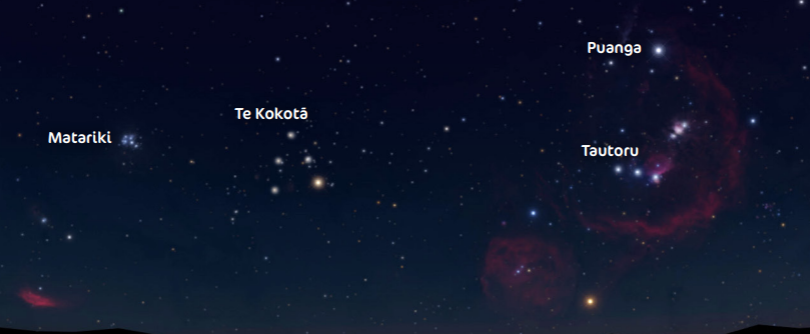Puanga and Matariki
In this Taringa podcast episode, special guests Che Wilson and Rangi Matamua join the crew to answer some audience pātai and speak in depth about the tikanga of Matariki and Puanga. (Starts at 25 minutes, 42 seconds)
Across different regions, iwi may acknowledge different stars to signify the Māori New Year. For some regions Matariki marks the new year. For others, Puanga is that star.
While Puanga and Matariki are both associated with the Māori New Year, they are not the same. It’s important to understand that accepting one cluster to mark the new year doesn’t disregard the other, as both Matariki and Puanga are important. Some iwi acknowledge and read both Matariki and Puanga for signs of what lies ahead in the new year. Many iwi from the west – including those around Whanganui, Taranaki, and parts of Te Taitokerau and the South Island – look to Puanga to mark their new year.
Matariki is a star cluster made up of nine stars, also known as Pleiades. Puanga is a single star, also known as Rigel. However, it is often grouped together with Puanga Hori (Procyon) and Whakaahu (Castor) under the name Puanganui-o-te-rangi.
Matariki and Puanga are both part of Te Waka o Rangi, the waka that carries the souls of those who passed away during the previous year. Matariki is at the front of the waka, and Puanga (along with Tautoru) is at the stern.
Both Matariki and Puanga set at the end of autumn for a period of about a month. Unlike Matariki, Puanga remains visible. When Matariki and Puanga rise in the early morning sky, it signifies the start of the Māori new year.
For more information about Puanga, we recommend you visit the Puanganui o te Rangi website.
Finding Puanga and Matariki
A great time to look for Puanga and Matariki is early in the morning before the sun rises in late Autumn. Turn to the east to get started.
Puanga is the fifth brightest star in the sky. Find the constellation of Tautoru, also known as Orion’s Belt or the Pot. The single bright star above this group of three is Puanga.
Once you have found Tautoru, look to the left. You will see the red giant Taumatakuku (Aldebran), part of the open star cluster Te Kokotā (Hyades), and to the left of that star you’ll see Matariki. See if you can count all nine stars that belong to the Matariki cluster.
Image kindly supplied by Stardome Observatory and Planetarium, 2023
